|
|
 |
Fiche d'espèce de Copépode |
|
|
Calanoida ( Ordre ) |
|
|
|
Clausocalanoidea ( Superfamille ) |
|
|
|
Scolecitrichidae ( Famille ) |
|
|
|
Diaiscolecithrix ( Genre ) |
|
|
| |
Diaiscolecithrix andeep Markhaseva, Schulz & Renz, 2010 (F) | |
| | | | | | | Ref.: | | | | 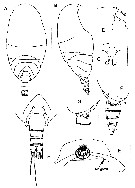 issued from : E.L. Markhaseva, K. Schulz & J. Renz in Arthropoda Selecta, 2010, 19 (3). [p.115, Fig.1, A-H]. Female (from 64°29'S, 02°53'E): A-B, habitus (dorsal and lateral, respectively); C, rostrum (frontal view); D, forehead (lateral); E, oral cone-like structure, distal part (ventral; Md gnthb = gnathobase of mandible); F, posterior and urosome (lateral); G, posterior prosome and genital double-somite (lateral, left side); H, posterior prosome and urosome (dorsal). Scale bars: 0.5 mm (A-B); remaining figures 0.1 mm. Nota : Rostrum as well developed plate with 2 filaments Cephalosome and pediger 1 and pedigers 4 and 5 seperate. Posterior corners of prosome as short triangular lobes with small distal points in lateral view. Upper and lower lips well developed to form circular oral cone-like structure, with distal parts supplied by edging of densely arranged setules. Urosome 4-segmented ; anal segment telescoped into preceeding. Genital segment (double-somite) symmetrical ; with slender spermathecae extending dorsally. Caudal rami with 4 terminal plus 1 ventral and 1 dorsal setae.
|
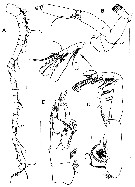 issued from : E.L. Markhaseva, K. Schulz & J. Renz in Arthropoda Selecta, 2010, 19 (3). [p.116, Fig.2]. Female: A, A1; B, A2; C, Mxp; D, P1 (anterior). Scale bars: 0.1 mm. Nota : A1 (24-segmented), slightly shorter than prosome.. A2 exopod 7-segmented, nearly 1.5 times as long as endopod (segment 1 with 1 seta, segment 2 with 8 and 6 setae. Mxp syncoxa with 1 worm-like sensory seta on proximal praecoxal endite ; 2 sensoru setae on middle endite, 1 worm-like and 1 brush-like, and 1 sclerotized seta on distal praecoxal endite ; coxal endite with 3 setae and row of spinules along distal and medial edge ; subterminal seta very small compared to proximal and terminal setae ; basis with 3 medial setae ; endopod 6-segmented, with 2, 4, 3, 3+1, and 4 setae. P1 coxa without seta ; basis with very small distolateral seta, medial distal seta smoothly curved ; 2 small denticles present on posterior surface ; endopod 1-segmented bearing lateral lobe ornamented with denticles and patch of denticles on anterior surface ; exopod segment 1 with patch of spinules on anterior surface and semicircular row of spinules on posterior surface
|
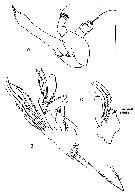 issued from : E.L. Markhaseva, K. Schulz & J. Renz in Arthropoda Selecta, 2010, 19 (3). [p.117, Fig.3]. Female: A, Md; B, Mx1 (setae on coxal and proximal basal endite are not given); C, Mx1 (setae on praecoxal arthrite, distal basal endite, endopod, exopod and epipodite are not given). Scale bar: 0.1 mm. Nota : Md gnathobase elongate, slender, with 2 strong, acutely pointed and 3 small teeth distally ; basis with 2 setae ; exopod 5-segmented, nearly as long as endopod, with 1, 1, 1, 1, and 2 setae ; endopod segment 1 without setae, segment 2 with 9 setae. Mx1 praecoxal arthrite with 7 terminal setae ; coxal endite, proximal basal and distal basal endite, each with 2 setae, latter with both sensory in distal parts ; endopod segments fused with 5 setae including 3 sensory ; exopod with 7 setae ; coxal epipodite with 8 setae.
|
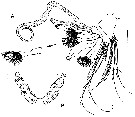 issued from : E.L. Markhaseva, K. Schulz & J. Renz in Arthropoda Selecta, 2010, 19 (3). [p.119, Fig.4, A, B]. Female: A, Mx2; B, P5. Scale bars: 0.1 mm. Nota : Mx2 praecoxa with outer hump ; proximal praecoxal endite with 3 setae ; distal praecoxal endite with 1 seta ; coxal endites with 1 sclerotized plus 1 worm-like sensory setae each ; proximal basal endite with 4 setae, of these 2 thin sclerotized and 2 worm-like sensory setae ; distal basal endite plus endopod with 8 setae (3 long worm-like sensory and 5 brush-like sensory setae of different morphology : 3thick with well developed brushes shown by arrow in fig.4A) and 2 longer setae with small and weakly developed brushes apically. P5 2-segmented, posteriorly with surface spinulation, terminal segment slightly longer than coxa, with terminal part narrowing and rounded distally and lacking spines.
|
 issued from : E.L. Markhaseva, K. Schulz & J. Renz in Arthropoda Selecta, 2010, 19 (3). [p.120, Fig.5]. Female: A, P2 (posterior); B, P3 (posterior); C, P4 (posterior; exopod incomplete). Scale bar: 0.1 mm.
|
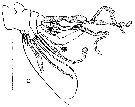 issued from : E.L. Markhaseva, K. Schulz & J. Renz in Arthropoda Selecta, 2010, 19 (3). [p.119, Fig.4, C]. Female copepodite V: C, Mx2 Scale bar: 0.1 mm. Nota : Mx2 with brush-like setae not fully developed (compare with Mx2 from female adult).
| | | | | NZ: | 1 | | |
|
Carte de distribution de Diaiscolecithrix andeep par zones géographiques
|
| | | | | | | Loc: | | | Antarct. (SE Atlant.) | | | | N: | 1 | | | | Lg.: | | | (1055) F: 1,51; {F: 1,51} | | | | Rem.: | Above seabed (depth: 2152; 2787 m).
For Markhaseva & al (2010, p.118, 121) the species shares with the only known female specimen Diaixis asymmetrica an elongate gnathobase of Md and details of setal armament of Mx1and a hump on Mx2. Grice & Hulsemann (1970) placed D. asymmetrica in the genus Diaixis, the species, however, does not fit well in the diagnostic characters of this genus and deviates for the A1 setation, Mx1 setation, sequence of setae on Mxp. Thus D. asymmetrica appears to be more closely related to Diaiscolecithrix. | | | Dernière mise à jour : 03/01/2015 | |
|
|
 Toute utilisation de ce site pour une publication sera mentionnée avec la référence suivante : Toute utilisation de ce site pour une publication sera mentionnée avec la référence suivante :
Razouls C., Desreumaux N., Kouwenberg J. et de Bovée F., 2005-2025. - Biodiversité des Copépodes planctoniques marins (morphologie, répartition géographique et données biologiques). Sorbonne Université, CNRS. Disponible sur http://copepodes.obs-banyuls.fr [Accédé le 17 octobre 2025] © copyright 2005-2025 Sorbonne Université, CNRS
|
|
 |
 |









